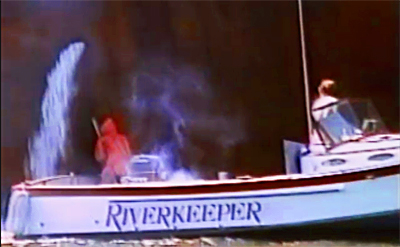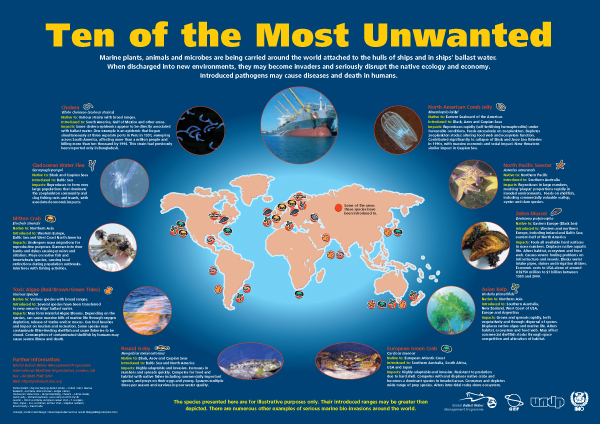Technological innovations that eliminate invasive aquatic species and pathogens from ship ballast water are spurring the growth of a multi-billion dollar industry. Ballast — water pumped into holds to balance and stabilize ships, sometimes by the millions of gallons — is often loaded from one waterway and discharged into another, in a different part of the planet. The global threat of harmful organisms that hitch a ride aboard international vessels gained worldwide attention through the Ballast Water Working Group and the Ballast Water Management Convention that emerged from the 1992 Earth Summit. Both are overseen by the UN’s International Maritime Organization (IMO).

1983 video capture of John Cronin bringing the 25-foot Hudson Riverkeeper vessel alongside the hull of a 750-foot Exxon oil tanker to sample its ballast discharge, with crew mate Andra Sramek (in orange foul weather gear).
In an exchange of emails with EarthDesk, Gail A. Gerono, Vice President of Investor Relations and Communications for Calgon Carbon Corporation in Pittsburgh, PA, wrote, “Estimates of the size of the ballast water treatment market range from $15 billion to $30 billion. This includes new ships (approximately 2,000 per year) and retrofits of existing ships (approximately 40,000). Based on the IMO Convention’s compliance dates and the US Coast Guard’s regulation, the market should peak around 2017.”
Calgon recently acquired Hyde Marine, which specializes in ballast treatment technology. “While looking for possible acquisition candidates, one of our executives learned about Hyde Marine and the pending IMO Convention to treat ballast water,” said Ms. Gerono. Calgon’s move into the ballast treatment arena offers a lesson that applies to a host of other water issues, global and domestic, in particular the Federal Clean Water Act (see Section 101), the primary goals of which expired unaccomplished three decades ago. From ballast discharges to untreated pharmaceuticals in water, the path from problem to solution usually leads through the marketplace and its entrepreneurs.

Invasives can originate from the U.S. too. Blue crab have made significant inroads in parts of Europe.
The IMO was able to foresee this: “Preventing the transfer of invasive species and coordinating a timely and effective response to invasions will require cooperation and collaboration among governments, economic sectors, non-governmental organizations and international treaty organizations.” (Emphasis added.)
If a ballast treatment industry alone is worth upward of $30 billion, imagine the value of a fully realized, U.S.-based, water innovation industry that comprehensively addresses water pollution, treatment, and monitoring. Unfortunately, this requires a level of collaboration amongst diverse stakeholders that has yet to materialize, despite the four decades that have lapsed since the passage of the Clean Water Act, the “technology forcing” statute that is the closest the U.S. comes to a national water policy.
The role of innovation in the future of domestic and global water issues will be the subject of continuing discussion here at EarthDesk.











No, it doesn’t always, look at fracking and nukes. I have a question maybe you can’t answer. Does Calgon Company take pride in solving this ballast problem or is it just another company that just “innovates” or buys companies that “innovate”? Are they one of the good guys or are they just another piece of the marketplace you talk about?
Innovations like those for treating ballast water are fine, as far as they go, but innovation has gotten us in as many troubles as it has solved. I saw on the Pace Academy website that you recently held a World Water Day that focussed on a community in Tanzania. That community does not need an innovation, it needs a well. I am wary of a national economy obsessed with “innovation.”
Hi Joseph, Thank you for your reply. I understand your point. First, we must distinguish between innovation and invention. It is true that a community in need of a well likely does not require a new invention. However, a well would certainly be an innovation for that same community, or perhaps the way the well is operated and maintained is an innovation. Ideally, innovations are aimed at making our lives better, most often using the marketplace to do so. Inventions go in almost any direction, good, bad, outright harmful. Innovations can be locale specific, even culturally or socially specific. An innovation can utilize a collection of inventions that have been around for years. I often use the example of Netlfix, which invented nothing, but created an innovation from the collected works and inventions of others. As for your wariness about an economy solely based on “innovation,” point taken. New and better stuff does not always equate with better lives. But I doubt we will get that horse back in the stable. I doubt the horse would even fit. Our job is to make innovation work for us, especially for a more Green future.